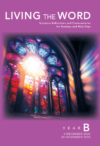Scripture Study for
Ascension of The Lord
Acts 1:1–11 / Psalm 47:6 / Ephesians 1: 17–23 or Hebrews 9:24–28; 10:19–23 / Luke 24:46–53
<< Back to LECTIONARY RESOURCES
Understanding the Word
By Dianne Bergant, C.S.A.
The confusion of the apostles provided Jesus the opportunity for one final instruction. He promised them the power of the Spirit to guide them in their endeavors. The cloud that took him from their sight is a traditional symbol of the presence of God. The two men in white garments are reminiscent of the two men at the tomb who announced the Resurrection. Though these men state that Jesus will return as he left them, the symbolic nature of this description prevented the disciples and us from knowing just what that might mean. Along with these disciples, we will have to depend upon the Spirit.
The prayer from Ephesians is for a threefold spiritual enlightenment, an enlightenment of the inner eyes. The petitioner asks that believers might know, 1) the hope of the calling that they have received from God, 2) the riches of the glory of God’s inheritance, and 3) the surpassing greatness of God’s power to those who believe. These marvels have already taken place; it is for the believers to acknowledge them in awe. The view of Christ contained in this passage is quite exalted. Having been raised from the dead, Christ now sits at God’s right hand, high above all of the other heavenly creatures.
In his last instruction to his disciples, Jesus explains how his death and resurrection had been foretold. There can be no question about the veracity of these events. As witnesses to them, the disciples are now to proclaim to all the nations that he did indeed die and rise, that he did preach repentance and forgiveness of sins. This last instruction was meant not only to bring the disciples themselves to Resurrection faith but also to commission them to bring this faith to the world. The actual description of the Ascension is quite brief in this account. There is neither grief nor fear on the part of the disciples. In fact, they return rejoicing and continue worshiping publicly in the temple.
